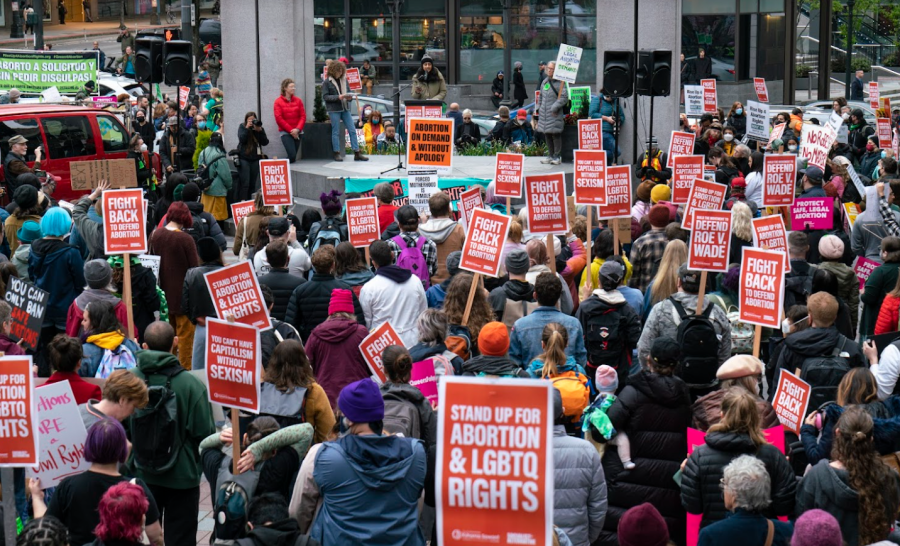A Reckoning for Roe
Protestors gather at Westlake Park in downtown Seattle to protest the leaked Supreme Court decision overturning Roe V. Wade.
“Hands off Roe v. Wade,” “out of your house and into the streets” and “Roe v. Wade is here to stay.”
All were chants that could be heard from the extensive crowd attending a May 3 rally at Westlake Park. The protestors organized in response to the leaked Dobbs v. Jackson Women’s Health Organization majority draft obtained by Politico, which would overturn the notable 1973 court case that legalized abortion, Roe v. Wade.
The protest started in Westlake Park with a number of community speakers, one of which was councilwoman Kshama Sawant. The group made its way marching up Pike Street, ending at Cal Anderson Park.
When Roe v. Wade established the legal right to abortion, it divided pregnancies into trimesters. The only trimester in which a state is able to fully ban abortion is the third trimester, when a fetus is considered viable. In the second trimester, a state could regulate abortion but only in protection of the pregnant person’s health.
Sital Kalantry, an associate professor of law at Seattle University, explained that Roe v. Wade established this viability framework, so states were unable to restrict abortion prior to viability.
“Once you burn Roe v. Wade down, you no longer have a constitutional right emanating from the U.S. Constitution that prevents states from enacting bans,” Kalantry said.
In 1992, the court upheld Roe v. Wade’s right to abortion pre-viability and also added an “undue burden” standard. This means that unless a restriction significantly burdens a pregnant person before viability, the restriction is allowed. Some states were able to enact restrictions on abortion due to the “undue burden” standard.
Dobbs v. Jackson, the current court case of contention, started as a lawsuit in response to Mississippi’s Gestational Age Act, which bans abortions after 15 weeks and penalizes providers who give abortions. If the ruling in the leaked draft stays steady, both Roe and Casey will be overturned.
The leak was celebrated by the U.S. Conference of Catholic Bishops, who released a statement asking the faithful to hold “witness to the beautiful gift of life with civility and love, and with our peaceful prayers and our compassionate service to all those in need.” The Catechism of the Catholic Church professes a womb-to-tomb ethic of life in which abortion, execution and assisted-suicide are all impermissible.
Some Democrats looked toward codifying abortion into federal law before the Supreme Court rules on the case through the Women’s Health Act. As of May 11, it did not pass due to insufficient votes in the Senate.
Jenny Brown, author of “Without Apology,” thinks that if the right to abortion is codified, there will still be barriers to access for people seeking abortion.
“Making the right to abortion the law of the land would be a good first step to deal with the immediate crisis, but we still have the problem of being able to pay for abortions,” Brown wrote to The Spectator. “The solution would be a national health insurance system that covers everyone for everything including abortion and birth control.”
There are various concerns about the potential effects of a Roe overturn. 13 states currently have laws called “trigger laws,” which are made to ban abortion in those states when Roe is overturned. In total, 25 to 26 states are likely to ban abortion at some point.
Washington is not one of the 25 to 26 states expected to ban abortion, but that does not necessarily mean those in Washington and other states that won’t ban abortion will not feel the effects.
“The immediate impact is going to be a surge of people coming into Washington for healthcare services. Therefore, abortion providers will be busier, the state might have to spend more money, women in Washington might have a harder time getting services,” Kalantry said. “The biggest worry is that once we have a Senate that is majority Republican, that just means 50 senators and a president that is anti-abortion, they will enact a nationwide ban on abortion.”
Once the rally ended in Cal Anderson, protestors expressed their own worries. Kelcey Hawthorne, a rally attendee holding a sign reading “f**k forced birth,” expressed why she feels that the country is moving backwards.
“It’s something that I never thought in a million years would happen when I was a kid. Now kids are seeing us go directly backwards into times that we are not supposed to be in and that is the scariest thing to me,” Hawthorne said.
Eric Ross, another attendee, echoed her concerns, saying the issue should have been solved decades ago.
“It’s a matter of justice, it’s a matter of healthcare and everyone should be out here protecting our freedoms and our rights,” Ross said.
The Supreme Court is expected to officially release the ruling within the next two months. Public organization is already underway, and the way the next two months will pan out is anyone’s guess.


